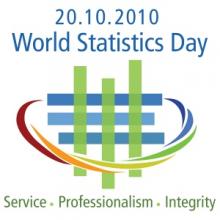European statistics: an information source for everyone
On 20 October, World Statistics Day1 is celebrated for the first time. This event highlights the importance of official statistics in our society. At EU level, efforts have been made over more than 50 years by the National Statistical Offices of the Member States, together with Eurostat, to produce reliable and comparable data. Nowadays European statistics are used in many different ways by a growing number of people.
To mark this Day, Eurostat, the statistical office of the European Union and the 27 National Statistical Offices of the Member States, which together form the European Statistical System2 (ESS), publish this common News Release illustrating the role of European official statistics.
Why are European official statistics so important?
European statistics present two main features which make them irreplaceable. They provide an average for the whole of the EU. They also give comparable data for each Member State, helping to illustrate the similarities and differences within the EU. Such European statistics exist across a wide range of fields – public finances, prices, external trade, labour market, health, education…
As one light-hearted example, European statistics3 can help to describe "average" European citizens. For a woman, she would be 42 years old, and can expect to live for a further 41 years. She was around 28 years old when she had her first child, and has less than two children3. She works in public or social services for about 33 hours a week3, and has completed at least upper secondary education. For a man, he would be 39 years old, and has a life expectancy of another 39 years. He works in market services for around 40 hours a week3, and has completed at least upper secondary education. Of course these figures only provide a benchmark against which citizens can compare themselves with their neighbours.
Users ranging from European Commissioners and governments to students and enterprises…
Today, European statistics play a key role in guiding government policy, in supporting decisions made by enterprises and in enabling citizens to judge progress and to compare themselves with their neighbours.
For example, European regional statistics guide the European Commission in the allocation of regional funding, while in the economic area, harmonised price statistics play a key role in the monetary policy of Central Banks. Business people use external trade statistics to investigate new opportunities across the internal market, while European citizens can compare taxation or unemployment in their country with other Member States. In 2011 a new population census will be launched in all Member States, and the results of these censuses will be vital, for example, at national level in decisions on the location of public infrastructure (schools, hospitals, energy supply, transport…) as well as at European level in the determination of voting weight in the European Council.
2. The ESS functions as a network in which Eurostat’s role is to lead the way in the harmonization of statistics in close cooperation with the national statistical authorities. The ESS also coordinates its work with EEA/EFTA countries, candidate countries, at European level with other Commission services, agencies and the ECB and international organisations such as OECD, the UN, the IMF and the World Bank.
3. These averages have been calculated as follows:
• Median age by sex in 2008
• Life expectancy at median age in 2007
• Women's age at first child in 2008
• Total fertility rate (number of children per women) in 2007. The exact EU average rate was 1.56.
• Employment by sector for those aged 25-49 in 2009
• Total usual hours worked by employees in 2009. The main reason for the difference between women and men in the number of hours worked per week is the higher share of women working part time.
• Educational level for those aged 25-49 in 2009



